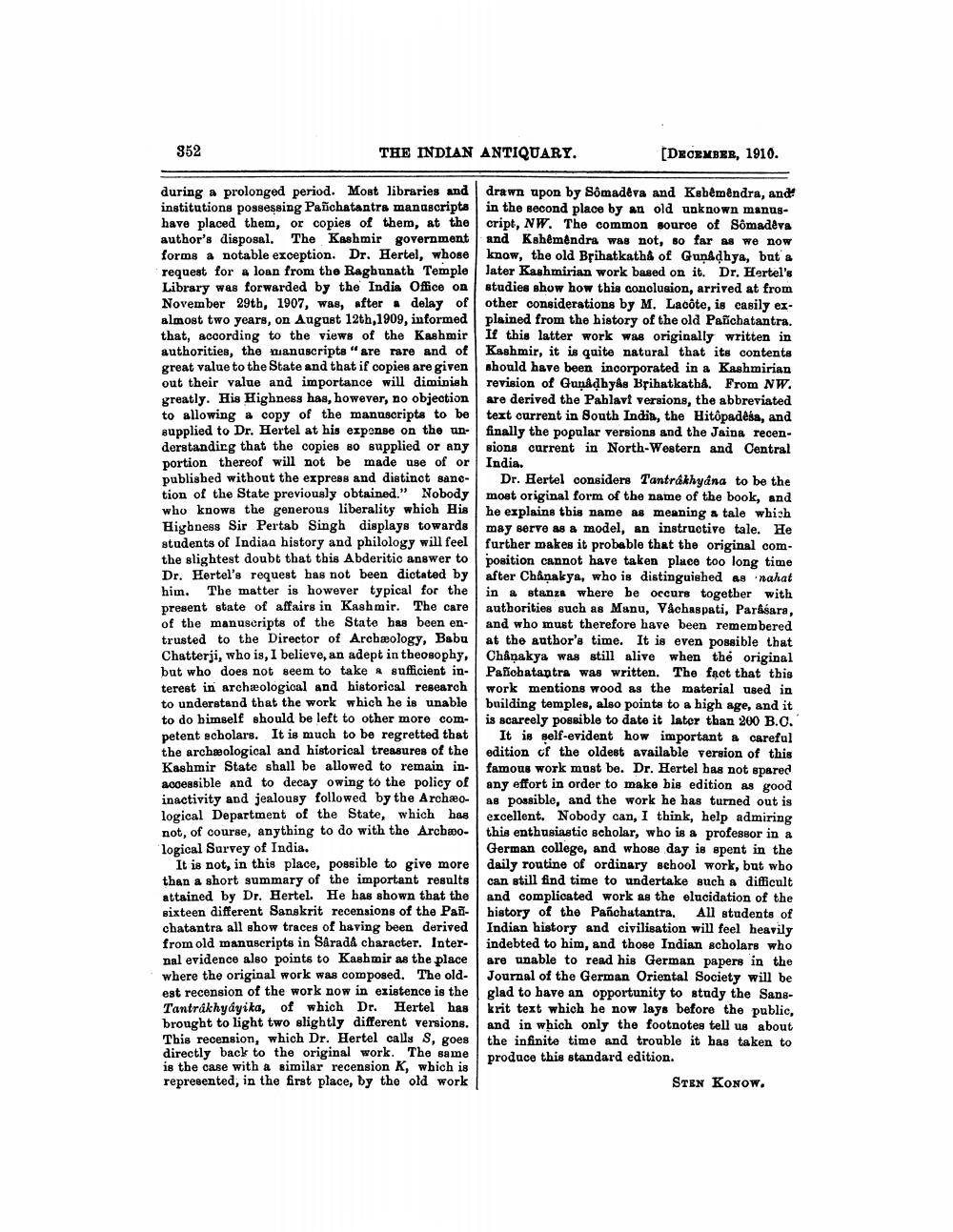________________
852
THE INDIAN ANTIQUARY.
[DECEMBER, 1910.
during a prolonged period. Most libraries and drawn upon by Sômadeva and Kabêmêndra, and institutions possessing Pañchatantra manuscripts in the second place by an old unknown manushave placed them, or copies of them, at the cript, NW. The common source of Somadera author's disposal. The Kashmir government and Kahêmêndra was not, so far as we now forms a notable exception. Dr. Hertel, whose know, the old Brihatkath of Gunsdhya, but a request for a loan from the Ragbunath Temple later Kashmirian work based on it. Dr. Hertel's Library was forwarded by the India Office on studies show how this conclusion, arrived at from November 29th, 1907, was, after delay of other considerations by M. Lacôte, is casily ex. almost two years, on August 12th, 1909, informed plained from the history of the old Palichatantra. that, according to the views of the Kashmir If this latter work was originally written in authorities, the manuscripts "are rare and of Kashmir, it is quite natural that its contents great value to the State and that if copies are given should have been incorporated in a Kashmirian out their value and importance will diminish revision of Gunadh A BrihatkathA. From NW. greatly. His Highness has, however, no objectionare derived the Pahlavt versions, the abbreviated to allowing a copy of the manuscripts to be text current in South India, the Hitôpadesa, and supplied to Dr. Hertel at his expense on the un- finally the popular versions and the Jains recenderstandirg that the copies so supplied or any sions current in North-Western and Central portion thereof will not be made use of or India. published without the express and distinct sane- Dr. Hertel considers Tantrákhyana to be the tion of the State previously obtained." Nobody moet original form of the name of the book, and who knows the generous liberality which His he explains tbis name as meaning a tale which Hichness Sir Pertab Singh displays towards may serve as a model, an instructive tale. He students of Indian history and philology will feel further makes it probable that the original comthe slightest doubt that this Abderitio answer to position cannot have taken place too long time Dr. Hertel's request has not been dictated by after Chanakya, who is distinguished as inahat him. The matter is however typical for the in a stanza where be ocenre together with present state of affairs in Kashmir. The care authorities such as Manu, Vachaspati, ParAsara, of the manuscripts of the State has been en- and who must therefore have been remembered trusted to the Director of Archaeology, Babu at the autbor's time. It is even possible that Chatterii, who is, I believe, an adept in theosophy, Chanakya was still alive when the original but who does not seem to take a sufficient in- Panobatantra was written. The fact that this terest in archæological and historical research work mentions wood as the material used in to understand that the work which he is unable building temples, also points to a high age, and it to do bimself should be left to other more com- is scareely possible to date it later than 200 B.O. petent scholars. It is much to be regretted that It is self-evident how important a careful the archaeological and historical treasures of the edition of the oldest available version of this Kashmir State shall be allowed to remain in- famous work must be. Dr. Hertel has not spared accessible and to decay owing to the policy of any effort in order to make bis edition as good inactivity and jealousy followed by the Archæo as possible, and the work he has turned out is logical Department of the State, which has excellent. Nobody can, I think, help admiring not, of course, anything to do with the Arcbao-this enthusiastic scholar, who is a professor in a logical Survey of India.
German college, and whose day is spent in the It is not, in this place, possible to give more daily routine of ordinary school work, but who than a short summary of the important results can still find time to undertake such a difficult attained by Dr. Hertel. He has shown that the and complicated work as the elucidation of the sixteen different Sanskrit recensions of the Pad- history of the Panchatantra. All students of chatantra all show traces of having been derived Indian history and civilisation will feel heavily from old manuscripts in Saradå character. Inter- indebted to him, and those Indian scholars who mal evidence also points to Kashmir as the place are unable to read his German papers in the where the original work was composed. The old- Journal of the German Oriental Society will be est recension of the work now in existence is the glad to have an opportunity to study the SansTantråkhyáyika, of which Dr. Hertel has krit text which he now lays before the public, brought to light two slightly different versions. and in which only the footnotes tell us about This recension, which Dr. Hertel calls S, goes the infinite time and trouble it has taken to directly back to the original work. The same
produce this standard edition. is the case with a similar recension K, which is represented, in the first place, by the old work
STEN KONOW.




